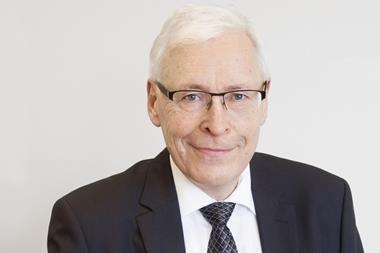Across Europe institutional investors are looking with increasing interest at alternative investments. Reports earlier this year by both Greenwich Associates and Mercers have highlighted that institutional investors foresee moving increasingly large amounts of the portfolio into alternative investments and this has been accompanied by unprecedented flows into this asset class. Nonetheless, over the last few years stated interest has not been matched by a commensurate inflow of institutional monies into hedge funds.
We believe that UCITS III is about to change this. Long-held as the framework which will enable retail investors to access alternative investments, in our opinion, it will also have a significant impact in the way institutional investors source alternative investments. UCITS III will become the standard framework, recognised by institutional and pension fund investors looking to invest in derivatives based products.
The original objective of the UCITS directive (introduced in 1985) was to allow for open-ended funds investing in transferable securities to be subject to the same regulation in every member state of the EU. The reality fell far short, but attempts to reform the directive in the mid 1990s failed through lack of common ground.
However, in 2001 UCITS III (made up of two directives, the Management and the Product Directives) was introduced. Although the primary aim of the directive was to facilitate the cross-border distribution of mutual funds, the Product Directive, for the first time, allowed funds to primarily invest in derivatives as a means of generating returns (as opposed to managing secondary risk and hedging etc).
So how and why will UCITS III impact the institutional arena or the hedge fund market? To begin, it is worth considering the nature of institutional pensions investors; they are cautious, responsible for the future of both scheme members and, increasingly, companies. They seek transparency, accountability, strong operational procedures and effective risk management. This contrasts markedly with the ethos of some boutique hedge funds. Originally the offspring of successful and ambitious proprietary trading desks, many have preserved a culture of overt confidence and secrecy, which made them so successful within investment banks. Even as they have proliferated and been joined by managers from traditional investment houses, in some areas of the hedge fund industry a culture of obfuscation, mystery and ‘trust me and I'll deliver' has still been preserved.
Thus the institutional investors who appreciate and understand the benefits of alternative investment strategies within a portfolio are reluctant to invest with single strategy, single manager hedge funds, unless they are either part of a well established investment firm or they have their own hedge fund due diligence team. Instead, pension funds tend to turn to funds of hedge funds, where the individual fund specific risks are limited through the broad diversification of the fund of fund investment approach.
UCITS III, however, will address the remaining concern regarding product risk for many institutional investors. The mandatory risk management process enshrined in UCITS III ensures that the manager remains within the predetermined limits at all times, focusing the manager's attention towards a careful analysis of risk, even before a position is taken. Thus UCITS provides a framework within which investment risk should be contained to the predefined risks inherent in the product's predetermined structure. In contrast, there are hedge funds, even when the managers are based in, for example, London, who will be regulated by the FSA and the administration if based in a European offshore centre, such as Dublin and will therefore be operating under the EU onshore regulatory standards, whose products may nonetheless not be managed within a regulated product investment risk management framework.
Within UCITS, this product related risk of investment managers unintentionally or intentionally taking risks beyond the client's expectations, inherent in some other offshore registered hedge funds, will be greatly limited and the UCITS badge will give investors and trustees the confidence to invest in these products. UCITS III alternative investment products may not be true hedge funds, covering all conceivable hedge fund styles, but if institutional investors can access 75% of what the main class of equity-long-short hedge funds achieve within a respected regulatory framework, which minimises day-to-day risk, they will do so.
This trend is likely to be supported by the increasing use of single strategy hedge funds we are seeing across the industry. As mentioned earlier, many institutions attempting to manage hedge fund manager/product risk have done so through diversification, by investing in a fund of hedge fund structures. But, many are beginning to turn from this. Often the returns are so diluted by over diversification and multiple fee layers so as to have a minimal impact on a pension fund's overall performance. Increasingly, investors looking for exposure to hedge fund strategies are approaching it as they would any other asset class; they are prepared to assume a degree of risk, the risk they are looking to minimise is uncompensated unintentional risk, or the risk they had not planned to take on and, as mentioned, within UCITS, this should virtually disappear.
The minimising of this risk will also, we believe, be welcomed by consultants, the gatekeepers of the institutional world. The UCITS framework will enable them to focus on the areas where they can really add value to their clients - asset allocation and a thorough analysis of investment strategies, rather than be bogged down by issues of basic ongoing due diligence.
For investment managers UCITS also greatly simplifies pan- European distribution. Once a UCITS fund is registered in any EU country, presenting and marketing the investment strategy to the institutional investment community does not face the obstacles created by private placement regulations in the marketing of other institutional products.
All these factors will contribute to a significant growth in the domestic European hedge fund industry, with institutions likely to increase their currently moderate investment in hedge fund strategies of some 13% of assets under management, to between 25 and 40%. But the impact of UCITS III is likely to go well beyond the borders of the EU. European pension monies currently invested in offshore hedge fund vehicles are likely to repatriate into UCITS products. Furthermore, international investors in Asia and the Middle East are looking for quality assurances, which the UCITS badge is able to provide more so, in some cases, than the local regulatory regime. With institutional assets in Asia ex Japan now exceeding $5trn (€3.85trn), and those in the Middle-east growing fast, the opportunities for UCITS funds and for the European fund management industry are significant.
The attracting of hitherto deterred investors sounds like good news for the hedge fund industry. However, it will also drive change that will not necessarily be restricted to the hedge fund sector.
The quality of reporting required by UCITS will raise the benchmark across the hedge fund industry and, we believe, establish industry best practice. While larger hedge fund houses are pressing for transparency and high quality reporting, this still presents a real challenge for some boutique hedge funds; swift reporting is costly and complicated and delivering the service that clients will come to expect, will present real difficulties for some.
Traditional asset managers will nonetheless have to adapt to market changes. They have the understanding of the regulatory regime, client concerns and requirements and are used to providing the level of service required. However, to this they must add specialist risk management expertise, previously only employed by investment banks to manage their trading desks risk exposures, enabling them to deliver successful and sophisticated investment products to clients.
This will have interesting implications for the UCITS regime as well. Rather than being the universal product standard for all retail investors, We believe that this will, at some point, only apply to ‘non-sophisticated' UCITS III, ie, funds which do not use derivatives to significant extents. The ‘sophisticated' UCITS III funds regime will enable institutional investors to continue to take advantage of the latest and most sophisticated of investment strategies within a regulated environment. Eventually, there may well be a segmentation of UCITS III fund investors into two distinct groups, those more comfortable with traditional long-only dominated investing and those keen to diversify their investments away from market investment risk cyclicality and towards manager driven investment risks.
Lothar Mente is head of product development and Celeste Dias product development manager at Threadneedle Investments














No comments yet